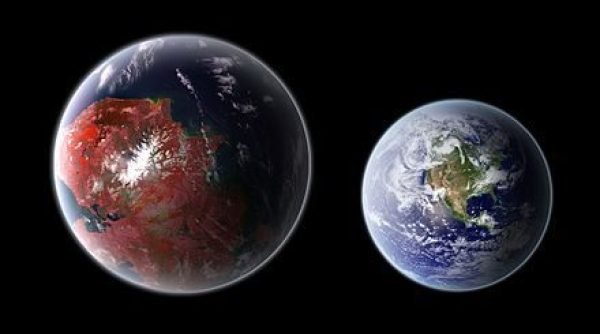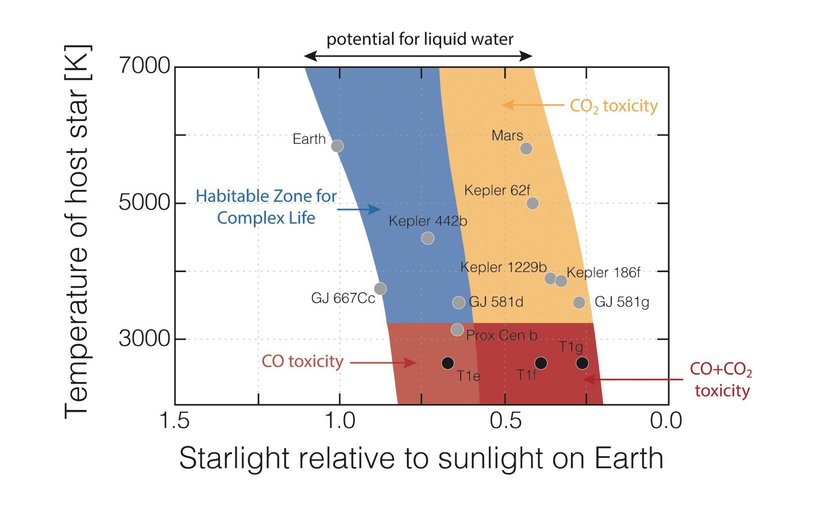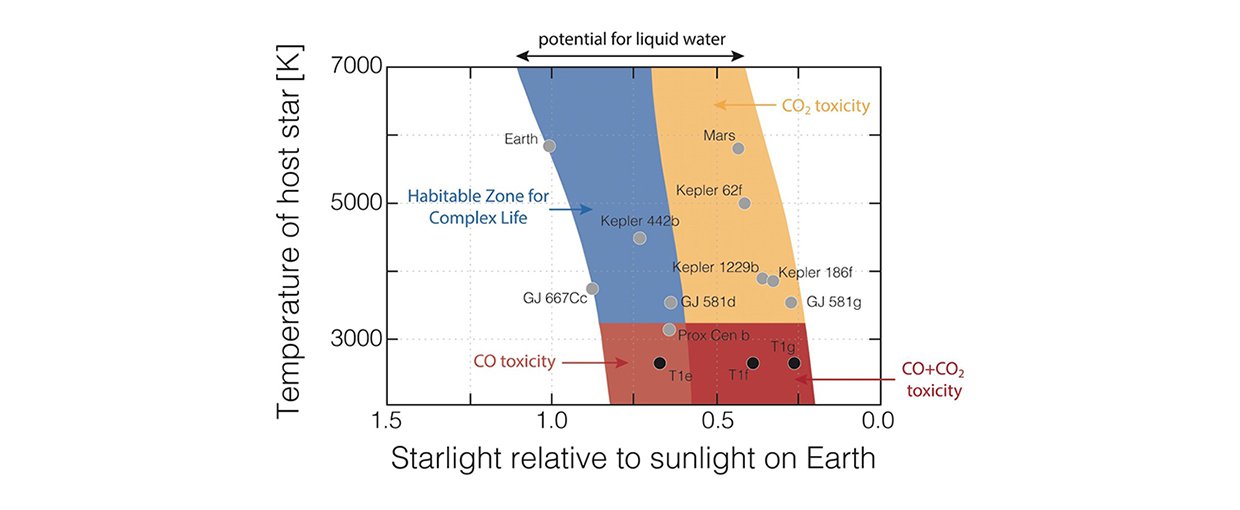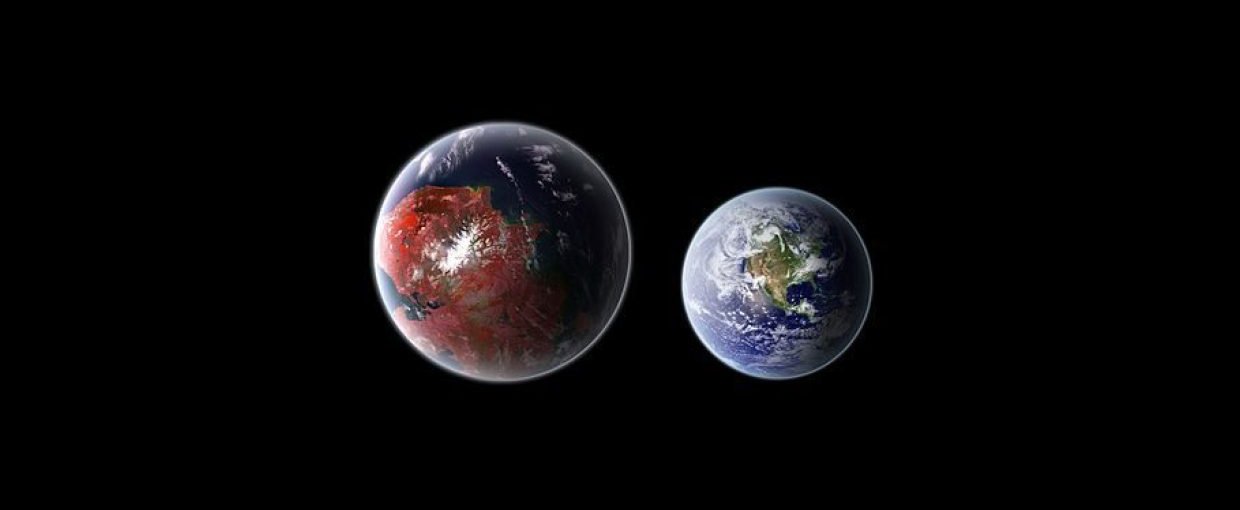

The term “habitable zone” can be a misleading one, since it describes a limited number of conditions on a planet to make it hospitable to life.Image credit: NASA.
For years now, finding planets in the habitable zones of their host stars has been a global astrophysical quest and something of a holy grail. That distance from a star where temperatures could allow H20 to remain liquid some of the time has been deemed the “Goldilocks” zone where life could potentially emerge and survive.
The term is valuable for sure, but many in the field worry that it can be as misleading or confusing as it is helpful.
Because while the habitable zone is a function of the physics and architecture of a solar system, so much more is needed to make a planet actually potentially habitable. Does it have an atmosphere? Does it have a magnetic field. Does it orbit on an elliptical path that takes it too far (and too close) to the sun? Was it sterilized during the birth of the host star and orbiting planets? What kind of star does it orbit, and how old and luminous is that star?
And then there’s the sometimes confused understanding that many habitable zones may well support complex, even technologically-advanced life. They are, after all, habitable.
But as a new paper in the Astrophysical Journal makes clear, the likelihood of a habitable zone planet being able to support complex life — anything beyond a microbe — is significantly limited by the amount of toxic chemicals such as carbon monoxide and excesses of carbon dioxide.

A rendering of the exoplanet Kepler 442 b, compared in size to Earth. Kepler 442 b was detected using the Kepler Space Telescope and is 0ne of a handful of planets found so far deemed to be most likely to be habitable. But it’s 1200 light-years away, so learning its secrets will be challenging.Image credit: Wikipedia.
Eddie Schwieterman, a NASA postdoc at the University of California, Riverside and lead author of the article, told me that the odds for complex life on most exoplanets in their habitable zones weren’t great.
“A rough estimate is between 10-20% of habitable zone planets are truly suitable for analogs to humans and animals.” he said. “Of course, being located in this part of the habitable zone isn’t enough by itself – you still need the build-up of oxygen via the evolution of oxygenic photosynthesis and certain planetary biogeochemical cycles.”
Timothy Lyons, one of the study’s co-authors, is a distinguished professor of biogeochemistry in UCR’s Department of Earth and Planetary Sciences, and director of the Alternative Earths Astrobiology Center, which sponsored the project. He described the new study as the “first time the physiological limits of life on Earth have been considered to predict the distribution of complex life elsewhere in the universe.”
“Imagine a ‘habitable zone for complex life’ defined as a safe zone where it would be plausible to support rich ecosystems like we find on Earth today,” Lyons said. “Our results indicate that complex ecosystems like ours cannot exist in most regions of the habitable zone as traditionally defined.”

Edward Schwieterman, spent six years at the University of Washington’s Virtual Planetary Laboratory. He now works with the NASA Astrobiology Institute Alternative Earths team UCR.Image credit: UCR.
The team used computer models to study atmospheric climate and photochemistry on a variety of planets, using known physiological limits on Earth as a guide and coming to their rather deflating prediction.
The new study concludes that carbon dioxide toxicity alone restricts simple animal life to no more than half of the traditional habitable zone. For humans and other higher order animals, which are more sensitive, the safe zone shrinks to less than one third of that area.
“To sustain liquid water at the outer edge of the conventional habitable zone, a planet would need tens of thousands of times more carbon dioxide than Earth has today,” Schwieterman said. “That’s far beyond the levels known to be toxic to human and animal life on Earth.”
In other words, the carbon dioxide needed as a greenhouse gas to keep a planet warm enough to be habitable — Earth included — could easily also make it uninhabitable
Carbon monoxide is also a major obstacle to life on many planets — including most likely the planets orbiting the two stars closest to ours, Proxima Centauri and TRAPPIST-1.
The type and intensity of ultraviolet radiation emitted by these cooler, dimmer stars can lead to high concentrations of carbon monoxide, the paper reports. Carbon monoxide binds to hemoglobin in animal blood, the compound that transports oxygen through the body. So even small amounts of it can cause the death of body cells due to lack of oxygen.
Carbon monoxide cannot accumulate on Earth because our hotter, brighter sun drives chemical reactions in the atmosphere that destroy it quickly. Although the team concluded recently that microbial biospheres may be able to thrive on a planet with abundant carbon monoxide, Schwieterman stressed that “these would certainly not be good places for human or animal life as we know it on Earth.”

Chart showing the habitable zone for complex life. The zone shrinks when the temperature of the host star and the amount of starlight reaching the planet are added, producing carbon monoxide and carbon dioxide toxicity.Image credit: Christopher Reinhard at Georgia Institute if Technology.
In a similar vien, Katherine Garcia-Sage et al argued In a 2017 Astrophysical Journal Letters paper that Proxima Centauri’s habitable zone experiences pulses of ultraviolet radiation hundreds of times greater than Earth does from the sun. That radiation generates enough energy to strip away not just the lightest molecules — hydrogen — but also, over time, heavier elements such as oxygen and nitrogen.
Their model shows Proxima Centauri’s powerful radiation drains the Earth-like atmosphere as much as 10,000 times faster than what happens at Earth. So there are many ways for a habitable zone planet to become uninhabitable.

Timothy Lyons is a distinguished professor of biogeochemistry in the Department of Earth Sciences.Image credit: UC Riverside.
The UCR Alternative Earths program focuses on the many different atmospheric, climate and other global physical conditions our planet has experienced over the eons, and seeks to understand possible habitable conditions on distant exoplanets with these models in mind. In this way, the presence of life on Earth is no longer our one example of life, but is many examples existing under quite different conditions.
As Schwieterman explained, for the majority of Earth history humans (and other animals) could not breathe the atmosphere because it lacked essential oxygen.
“Changing environmental conditions, with the oxygenation of the atmosphere central, coupled with evolution allowed for the expansion and diversification of life into the forms we see today,” he tole me. “Also, we notice that there are many (current) environments with extremes in temperature, acidity, salinity, etc. that are populated by extremophilic bacteria and archaea, but that do not host eukaryotic (more complex) animals or plants. ”
“When planetary scientists, astronomers, and astrobiologists typically talk about ‘habitability,’ they’re usually referring to the temperature and other conditions amenable for the simplest life, which is necessary but not sufficient for advanced life.
“This is evident,” he said, “when discussing the past habitability of Mars. Liquid water on its past surface may have been suitable for microorganisms, but few contend ancient Mars may have evolved animals. I just want to make it very clear that the term ‘habitability’ can often be misunderstood to something like the approximation ‘humans could live there,’ which is not typically the case.”
Given these limiting factors for complex extraterrestrial life, does that mean it doesn’t exist?
Well, we can’t say that because with billions of billions of exoplanets out there, a tiny percentage of planets with the right conditions could still be substantial number. But we can say that it is becoming increasingly likely that the percentage of exoplanets that could support complex life as we know it is very small indeed.
Related Links:
New Discovery Shows ‘Habitable Zone for Complex Life’ is Much More Narrow than Original Estimates


